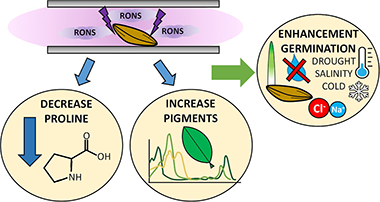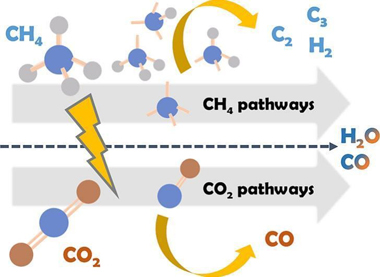Scientific Papers in SCI
2023
2023
Nanotecnología en Superficies y Plasma
Cobalt Stabilization through Mesopore Confinement on TiO2 Support for Fischer-Tropsch Reaction
Platero, F; Todorova, S; Aoudjera, L; Michelin, L; Lebeau, B; Blin, JL; Holgado, JP; Caballero, A; Colón, GACS Applied Energy Materials, 6 (2023) 9475-9486
Show abstract ▽

Cobalt supported on mesostructured TiO2 catalysts has been prepared by a wet-impregnation method. The Co/TiO2 catalytic system showed better catalytic performance after support calcination at 380 °C. Co nanoparticles appeared well distributed along the mesopore channels of TiO2. After reduction pretreatment and reaction, a drastic structural change leads to mesopore structure collapse and the dispersion of the Co nanoparticles on the external surface. Along this complex process, Co species first form discrete nanoparticles inside the pore and then diffuse out as the pore collapses. Through this confinement, a strong metal–support interaction effect is hindered, and highly stable metal active sites lead to better performance for Fischer–Tropsch synthesis reaction toward C5+ products.
September, 2023 | DOI: 10.1021/acsaem.3c01432
Nanotecnología en Superficies y Plasma
Germination and First Stages of Growth in Drought, Salinity, and Cold Stress Conditions of Plasma-Treated Barley Seeds
Perea-Brenes, A; Garcia, JL; Cantos, M; Cotrino, J; Gonzalez-Elipe, AR; Gomez-Ramirez, A; López-Santos, CACS Agricultural Science & Technology, 3 (2023) 760-770
Show abstract ▽

Numerous works have demonstrated that cold plasma treatments constitute an effective procedure to accelerate seed germination under nonstress conditions. Evidence also exists about a positive effect of plasmas for germination under environmental stress conditions. For barley seeds, this work studies the influence of cold plasma treatments on the germination rate and initial stages of plant growth in common stress environments, such as drought, salinity, and low-temperature conditions. As a general result, it has been found that the germination rate was higher for plasma-treated than for untreated seeds. Plasma also induced favorable changes in plant and radicle dimensions, which depended on the environment. The obtained results demonstrate that plasma affects the biochemical metabolic chains of seeds and plants, resulting in changes in the concentration of biochemical growing factors, a faster germination, and an initially more robust plant growth, even under stress conditions. These changes in phenotype are accompanied by differences in the concentration of biomarkers such as photosynthetic pigments (chlorophylls a and b and carotenoids), reactive oxygen species, and, particularly, the amino acid proline in the leaves of young plants, with changes that depend on environmental conditions and the application of a plasma treatment. This supports the idea that, rather than an increase in seed water imbibition capacity, there are clear beneficial effects on seedling of plasma treatments.
September, 2023 | DOI: 10.1021/acsagscitech.3c00121
Nanotecnología en Superficies y Plasma
Plasma assisted dry reforming of methane: Syngas and hydrocarbons formation mechanisms
Navascues, P; Cotrino, J; Gonzalez-Elipe, AR; Gomez-Ramirez, AFuel Processing Technology, 248 (2023) 107827
Show abstract ▽

Plasma reactions of CO2 + CH4 mixtures have been proposed as a suitable process for the dry reforming of methane. Without specific catalysts, most studies report the formation of CO and H2 as main reaction products and arise the question whether CHx radicals coming from CH4 may interact with intermediate species formed by electron impact dissociation of CO2, a critical step for the formation of high added value oxygenated compounds. We have addressed this question studying the CO2 + CH4 plasma reaction in a ferroelectric-moderated packed -bed reactor varying the reactants ratio. Analysis of the reaction products by mass spectrometry and the plasma reaction intermediates by optical emission spectroscopy suggest that few direct cross-link interactions exist between intermediate plasma species issued from CH4 or CO2. This preliminary evidence is corroborated by experiments using 13CO2 instead 12CO2 as reactant. The isotope labeling procedure has proved that plasma re-action mechanisms of CO2 and CH4 molecules proceed almost independently, with the formation of small amounts of water and the removal of carbon deposits resulting CH4 plasma decomposition as sole evidences of cross reactions. These results highlight the need of using catalysts to promote specific surface reactions for a better control of the selectivity of the process.
September, 2023 | DOI: 10.1016/j.fuproc.2023.107827
Química de Superficies y Catálisis
Process design and utilisation strategy for CO2 capture in flue gases. Technical assessment and preliminary economic approach for steel mills
Navarro, JC; Baena-Moreno, FM; Centeno, MA; Laguna, OH; Almagro, JF; Odriozola, JARenewable & Sustainable Energy Reviews, 184 (2023) 113537
Show abstract ▽
The steel industry is the most relevant sector in emerging economies due to its application in numerous fields. However, steel manufacturing involves large energy investment and produces significant greenhouse gas emissions. The current world economic and environmental scenario therefore necessitates that improvements in the footprint of the steel industry be made without affecting its viability. Considering the present challenge, we report two possible processes for Carbon Capture and Utilization (CCU). The first process is the competitive capture of CO2-SO2, followed by CO2 valorisation to methane. However, the CO2 capture capacity and lifetime for the adsorbent after multiple cycles could be improved through preliminary desulphurization of the gas current. The improved system demonstrates net profitability in a typical stainless steel plant. Therefore, it can be implemented in an industrial setting without profitability loss to steelmaking operations, fulfilling bot the goal of reducing CO2 emissions while protecting the mainstay of the plant.
September, 2023 | DOI: 10.1016/j.rser.2023.113537
Materiales Semiconductores para la Sostenibilidad
Understanding ice and water film formation on soil particles by combining density functional theory and Casimir-Lifshitz forces
Bostrom, M; Kuthe, S; Carretero-Palacios, S; Esteso, V; Li, Y; Brevik, I; Gopidi, HR; Malyi, OI; Glaser, B; Persson, CPhysical Review B, 108 (2023) 125434
Show abstract ▽
Thin films of ice and water on soil particles play crucial roles in environmental and technological processes. Understanding the fundamental physical mechanisms underlying their formation is essential for advancing scientific knowledge and engineering practices. Herein, we focus on the role of the Casimir-Lifshitz force, also referred to as dispersion force, in the formation and behavior of thin films of ice and water on soil particles at 273.16 K, arising from quantum fluctuations of the electromagnetic field and depending on the dielectric properties of interacting materials. We employ the first-principles density functional theory (DFT) to compute the dielectric functions for two model materials, CaCO3 and Al2O3, essential constituents in various soils. These dielectric functions are used with the Kramers-Kronig relationship and different extrapolations to calculate the frequency-dependent quantities required for determining forces and free energies. Moreover, we assess the accuracy of the optical data based on the DFT to model dispersion forces effectively, such as those between soil particles. Our findings reveal that moisture can accumulate into almost micron-sized water layers on the surface of calcite (soil) particles, significantly impacting the average dielectric properties of soil particles. This research highlights the relevance of DFT-based data for understanding thin film formation in soil particles and offers valuable insights for environmental and engineering applications.
September, 2023 | DOI: 10.1103/PhysRevB.108.125434
- ‹ previous
- 14 of 410
- next ›














